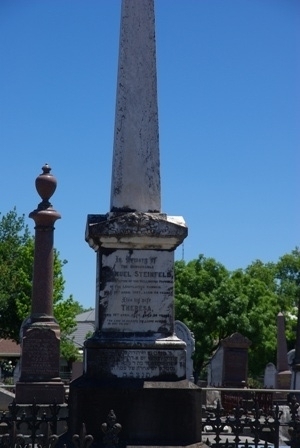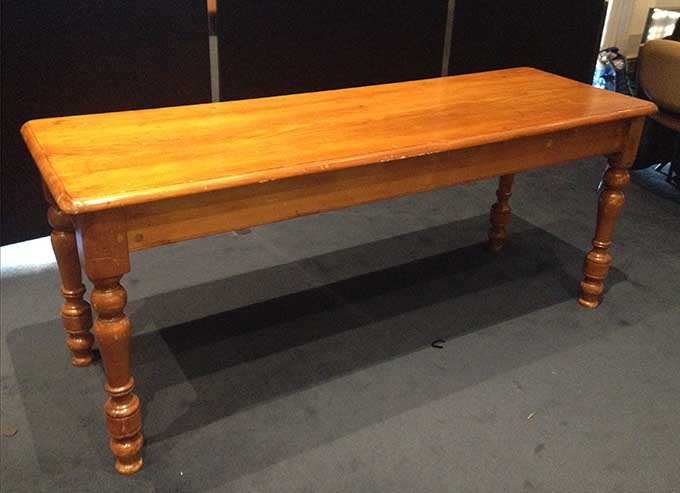Emanuel Steinfeld

Emanual Steinfeld gravestone in the Ballaarat Old Cemetery, 1913. Photograph: Clare Gervasoni
Contents
Background
Steinfeld was born in Prussia in 1828.[1]. He married Teresa.
Steinfeld died 16 April 1893, aged 64 years. He is buried in the Ballaarat Old Cemetery.
Goldfields Involvement, 1854
Post 1854 Experiences
From 1866 to 1869 Steinfeld was Mayor of Ballarat East, and from 1887 to 1888 Steinfeld was President of the Victorian Chamber of Manufacturers. [2]
A move to St Kilda in 1870 saw Steinfeld open a furniture business with his brother in law Hyman Levinson. [3]
Obituary
The late Mr Steinfeld[4]
In the News
- We regret to have to announce the death of Mr. Hyman Levinson of St Kilda, Melbourne. The deceased gentleman had been unwell for some days suffering with rheumatism which, touching the heart, caused serious symptoms to appear. His constitution was however so strong that he could cope with his infirmities until on Friday morning, the 14th inst, while Dr. Joske was present with his patient, Mr. Levinson was stricken with an apoplexy from which he never recovered, but died peacefully with his family by his bedside at three o'clock in the morning of Friday the 21st inst. The deceased gentleman was 71 years of age. He was born at Posen in February 1834 and at the age of nine went with his parents to Sheffield. Though he left his native town thus early, his recollections of it were to the last phenomenally clear and accurate. In Sheffield he remained till 1854, when, at that time 20 years of age, he came to Victoria in company with the late Mr. Abraham Myers, his cousin, late of Ballarat and of Dunedin, on board the 'Marco Polo' a small sailing ship which carried 300 immigrants to the land of the new found goldfields. Arriving in Melbourne he found his way almost at once to Ballarat, then in the midst of the turbulence which preceded the riots. He pitched his tent and set out in a make-shift window his small watchmaker's stock-in-trade. In the riotous days which fol lowed, he lost his modest possessions and narrowly escaped with his life. In later years he used to tell how the troops under Captain Wise were drawn up on both sides of the main road, quite near to his own tent, when a rough digger crept into the shelter of his canvas and deliberately took aim at the captain with a revolver. He remonstrated with the man, pointing out to him that if a shot, were fired, the Military would reply, directing their fire towards them and that they would both be killed. Failing in his efforts to dissuade the man he promptly called the attention of the officer to the situation. The miscreant, shrunk away, and soon tbe troops left the scene, not to appear again until after the stockade had been taken. But after they had gone Mr. Levinson saw a file of diggers approaching him. They attacked him, destroyed his belongings, and drove him to refuge in a shop kept by a Mr. Abrahams in the Main Road where he remained in biding for some days till the sound of the jingling of swords in the early morning of Sunday, the 3rd December told its story that the troopers were about again and the Eureka Stockade had been taken. He used to say that he was one of the very first to visit the scene of the conflict, which he would describe in after years in the minutest detail. Recently he had the satisfaction of receiving a special invitation from the committee, which arranged the cele brations upon the fiftieth anniversary of the event. He was familiar with all those who, like Peter Lalor, were figures of those stirring days. Indeed throughout the long period of his connection with Ballarat he was acquainted, sometimes intimately, with all its public men and his reminiscences were equivalent to a history of the town he dearly loved. In 1860 Mr. Levinson paid a visit to his parents in England, returning in the Great Britain with his sister, who became the wife of his partner of later years, and Miss Augusta Jacobs, third daughter of Mr. E. Jacobs of Manchester, and sister of Mr. Isaac Jacobs of Melbourne, the lady who was destined to become his wife, and to whom he married at St Kilda (Melbourne) on the 20th March, 1861. Soon afterwards he resigned his first business into the hands of his brother, Mr. Mark Levinson, now of Perth, upon his own appointment as Official Assignee in Insolvency, an office he held for many years, accumulating a wide knowledge of Insolvency Law. In 1877 he joined the late Mr. Emanuel Steinfeld (afterwards member of the Legislative Council for the Wellington Province) in the firm of Steinfeld, Levinson and Co. He thereupon removed to Melbourne, and since 1879 he has resided at St. Kilda. In 1888 both he and Mr. Steinfeld retired from business. Mr. Levinson, however, retained the office of Official Liquidator, which he filled till the time of his death. Since relinquishing business he has lived a retired life, deeply interested in com munal affairs, though of late his age and in firmities prevented him from taking an active part in them, deeply interested besides in the history and the present conditions of the Jewish people and in the consideration of scientific and philosophical subjects. In Ballarat he gave invaluable services to the local public and charitable institutions. He was one of the founders of the Ballarat Orphan Asylum and one of its first presidents, and its superintendent has frequently declared that it is in no small measure due to his early advice and guidance that that institution s probably the best managed and most successful institution of its kind in Australia. He was at one time president of the local hospital and for many years a member of its committee, and some of his practical ideas carried out then and there have since been adopted by all the hospitals of Victoria. He was director of various companies, notably of the famous Newington and Winter's Freehold claims. In Masonry he was a Past Master of the Yarrowee Lodge and Past Junior Grand Warden of the Grand Lodge. He was one of the founders of the Ballarat Synagogue, and was in turn secretary, treasurer and president of the local Congregation. Later he served for many years on the committee of the St. Kilda Hebrew Congregation, and in his time held the offices of president and treasurer. He was a loyal and observant and liberal minded Jew. It is 17 years since Mr. Levinson retired from business but his reputation in commercial circles for integrity, and ability remains a distinguished one. Deliberate and wise, his opinion was always valuable and his advice was often sought and always with advantage, especially in matters of finance, whether commercial or public, in which he was remarkably well qualified.
- Mr. Levinson leaves a widow and a united family of 12 children and 17 grandchildren. His relatives in Sydney are Mrs. W. Zander (daughter) and Mrs. C. Nettheim (sister). The funeral took place on Sunday, the 23rd inst., leaving the deceased gentleman's late residence, Chatsworth,' Beaconsfield Parade, St. Kilda, for the St Kilda Cemetery, where the Rev. Dr. Abrahams ministered at the grave. [5]
See also
Further Reading
Corfield, J.,Wickham, D., & Gervasoni, C. The Eureka Encyclopaedia, Ballarat Heritage Services, 2004.
References
- ↑ Rubenstein, Hilary, The Jews in Australia Vol. 1, William Heinemann Australia, 1991.
- ↑ Rubenstein, Hilary, The Jews in Australia Vol. 1, William Heinemann Australia, 1991.
- ↑ Rubenstein, Hilary, The Jews in Australia Vol. 1, William Heinemann Australia, 1991.
- ↑ Adelaide Observer, 22 April 1893, p. 28 Col e
- ↑ Hebrew Standard, 28 April 1905.
- ↑ Wickham, D., Gervasoni, C. & Phillipson, W., Eureka Research Directory, Ballarat Heritage Services, 1999.

